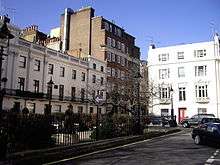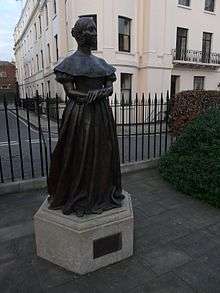Victoria Square, London
Victoria Square is a small,[lower-alpha 1] rectangular garden square 50 metres south of the remaining stables of The Royal Mews (on the large green block taken up by Buckingham Palace) and 150 metres north of Victoria bus station (which stands in front of Victoria Station (London)). It has a statue of the young Queen Victoria.


It separated by the main wing of the Goring Hotel from an almost identical-size space between buildings, as private gardens for the hotel, backed by one road, instead of its four private close-style roads with parking and sets of pavements.
Most of the Victoria and Belgravia area is the Duke of Westminster's Grosvenor Estate as to minor, overarching legal interests, the more valuable freehold of let shops and as to open spaces; this square is such an instance, which has a lasting influence on local planning policy and which has had some loss of interest by outright sales, some of which facilitated by the laws of leasehold reform.
Architecture and history
Fronting the square are 26 houses, which are all Grade II* listed which is the second tier (and so second-rarest) of the pyramidal-hierarchy protection and recognition system. These are five-storey stucco-fronted properties designed by architect Sir Matthew Wyatt (1805–1886), a member of the Wyatt family — son of sculptor Matthew Cotes Wyatt and the grandson of James Wyatt;[1] seeing them built in 1838–40[2] to celebrate the beginning of Queen Victoria's reign.
Most of the houses fronting are now held as freeholds, the residual interest in their leases (reversions) having been bought from the Grosvenor Estate. Protection of planning law of character in this zone has been strengthened to preserve the appearance of Belgravia.[lower-alpha 2]
Renovation
The private gardens were in the 2000s decade renovated; for which residents gave between £100,000 and £1M in total. A statue of the young Queen Victoria by the artist Catherine Anne Laugel was specially commissioned then installed, in 2007.
Former residents
- Author Ian Fleming (1908–1964) from 1953 until his death in 1964.[3] The first of his James Bond novels, Casino Royale, was published shortly after he took his house, where he threw a post-premiere of From Russia with Love party on 10 October 1963 - at № 16.
- Conservative Government Minister, then journalist, author and travel journalist, Michael Portillo (born 1953).[4]
- Poet Thomas Campbell (1777–1844) from 1840 to 1844 - at № 16.
- Musician John Ella (1802–1888) from 1868 to 1888 - at № 16.[5]
- Army officer, artist and author Henry Hope Crealock (1831–1891) from the 1860s until 1891- at № 20
- Musician and composer Mike Oldfield for some time - at № 1.
Appearance in film
In 1991, the square was used for the filming of the Merchant Ivory Productions adaptation Howards End.[6]
Notes and references
| Wikimedia Commons has media related to Victoria Square, London. |
- Footnotes
- 170 feet (52 m) by 75 feet (23 m), including roads, the few parking bays and the pavements
- Namely by the Grosvenor Belgravia Estate Management Scheme, approved by the High Court in 1973 under section 19 of the Leasehold Reform Act 1967
- References
- Curl, James Stevens (2006). A Dictionary of Architecture and Landscape Architecture. Oxford University Press.
- Hibbert, Christopher (2011). The London Encyclopaedia. Pan MacMillan.
p975
- Pearson, John (2011). The Life of Ian Fleming. Bloomsbury.
- Town, London. "Victoria Square, Pimlico, London SW1W | Nearby hotels, shops and restaurants | LondonTown.com". Victoria Square Guide. Retrieved 4 January 2015.
- Bashford, Christina (2007). The Pursuit of High Culture: John Ella and Chamber Music in Victorian London. Boydell Press. pp. 280–281.
- "Howards End". Retrieved 24 January 2017.